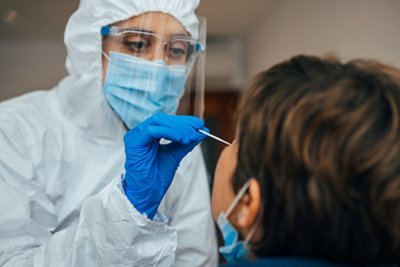Sepsis in the Neonatal Intensive Care Unit: The Need for Diagnostics and Dedicated Antimicrobial Stewardship Teams
By the bioMérieux Editors | Reading time: 3 min
PUBLICATION DATE: SEPTEMBER 13, 2023
Sepsis, a life-threatening clinical condition, can develop in anyone; however, infants younger than one year are at higher risk of developing an infection that could lead to sepsis.
Neonatal sepsis occurs in infants less than 28 days old and continues to be a leading cause of sickness and mortality among babies. Premature neonates are at a higher risk for infections and sepsis than those born at term, mainly due to an immature immune system and the increased need for invasive devices, which increase the risk for infections.
There are two main presentations of sepsis in neonates: early-onset sepsis (EOS), typically defined as occurring at or before 72 hours of life, and late-onset sepsis (LOS), which occurs any time after 72 hours of life. EOS is generally caused by the transmission of pathogens from the mother to the fetus/newborn, such as Group B streptococcus (GBS), E. coli, and L. monocytogenes. LOS is usually brought on by transmission of pathogens from the surrounding environment after delivery, healthcare workers, or caregivers.
In addition to measures addressing symptoms and conditions associated with sepsis, the typical treatment for suspected neonatal sepsis is empiric antibiotic therapy, including ampicillin and aminoglycosides to cover the most common pathogens, with the goal of treating the underlying infection. This strategy can be initiated quickly (as soon as sepsis is suspected) and is often lifesaving for patients with bacterial sepsis. However, using antibiotics when they are unnecessary can have negative consequences, and appropriate prescribing in the Neonatal intensive care unit (NICU) can be uniquely challenging.
Antibiotic Overuse in the NICU Can Have Negative Effects
When used for proven infections, antibiotics have dramatically improved survival in neonates. However, antimicrobial therapy use is high in NICUs, especially for potential sepsis. A global point prevalence survey found that on a given day, 26% of infants in NICUs received at least one antimicrobial, and the most frequent reason was for possible sepsis. The study also found that infants often received antimicrobial therapy based on clinical suspicion of infection or sepsis, rather than positive bacterial results—in fact, 49% of infants received prolonged therapy without any microbiological evidence of infection.
Antibiotic overuse has been associated with adverse outcomes, including LOS, invasive candidiasis (a type of serious fungal infection), and necrotizing enterocolitis (a type of serious intestinal infection), among others. A retrospective study found that among preterm, very low birth weight infants without major congenital anomalies or culture-proven sepsis, each day of antibiotic therapy provided in the first two weeks of age was associated with an increased risk of LOS or death.
In addition to adverse patient outcomes, overuse of antibiotics in NICUs can facilitate the emergence and spread of multi-drug resistant organisms, which can make treating infections in neonates more difficult. Neonatal infections from multi-drug resistant strains are associated with increased mortality, excessive cost, and prolonged hospitalization.
Reducing Antibiotic Overuse in the NICU
Given that Antimicrobials are the most frequently used medication in the NICU, antimicrobial stewardship efforts to minimize overuse and misuse of antibiotics in this setting are critical in the fight against AMR. The point prevalence survey found that hospitals that had a NICU-specific antimicrobial stewardship program (ASP) had significantly lower rates of antibiotic utilization. “The importance of such a program cannot be over-emphasized as it ultimately may help to decrease antimicrobial resistance in NICUs worldwide,” said the authors.
Diagnostics are a crucial part of antimicrobial stewardship programs and their utilization can support antimicrobial stewardship initiatives and patient outcomes. The swift and appropriate use of laboratory tools and testing can help to reduce unnecessary antibiotic use in neonates. For example, in diagnosis of neonatal sepsis, biomarkers including CRP, procalcitonin, jand interleukins 6 and 8 have been successfully used to help clinicians rule out infection. As a result, clinicians are able to safely refrain from prescribing antibiotics or discontinue antibiotic treatment, both of which reduce unnecessary antibiotic use.
Besides reducing unnecessary antibiotic use, antimicrobial stewardship efforts also focus on optimizing antibiotic use. For empiric antibiotics, “The choice of appropriate antimicrobial treatment is important and should be based on the epidemiological and microbiological data of each NICU.” Then, once identification and antibiotic susceptibility information are available, the results should be used to guide adjustments to antibiotic therapy.
As the authors of Antimicrobial Stewardship in the Neonatal Intensive Care Unit: An Update conclude, “Newborns are often administered prolonged antimicrobial treatments for suspected neonatal sepsis with severe short-term and long-term effects. The judicious use of antimicrobials in NICUs is vital for the protection of this vulnerable population.” Antimicrobial stewardship supported with diagnostic tools can help clinicians curb AMR while reducing the chances of adverse effects and further health complications in neonates.
You may be interested in these articles
SHARE THIS:
- Sepsis


